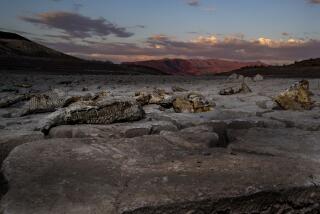Drought Hits Fever Pitch in Southwest
TUCUMCARI, N.M. â For nearly two decades, Alta Wadlow has toughed it out alone on this hard-scrabble prairie.
But like most cattle ranchers in the Southwest this year, Wadlow, 65, got caught in an economic squeeze not seen since the great droughts of the 1930s. Scorching sun, lashing winds and scant rainfall--combined with record high feed costs and low beef prices--drove her too deep into the red.
After 17 years of mending fences, rounding up strays, nurturing fragile prairie grass and tending 220 cows and calves, Wadlow has called it quits.
âI did it all myself. . . . Selling my herd wasnât hard to do,â said Wadlow, who now âdoes grunt work for someone elseâ at a veterinary hospital in town. âIt was simply a matter of not being able to feed them properly. I hate to see skinny cows, so I sold them.â
Now the nervous chatter heard around town begins: âDid you hear Alta sold her cows? I wonder whoâll be next?â
Two hundred miles to the east in Albuquerque--and throughout the Southwest--heat, wind and lack of rain have created potentially catastrophic fire conditions.
In areas where urban development bumps up against nature, firefighters are trying to save lives and homes in places where arsonists prowl and residents wake with an eye toward the skies and a prayer for plentiful moisture.
It is shaping up to be an extraordinarily long, hot summer of defeat in the fields, range lands and forests. The trouble is, things started heating up as early as January.
And the results are staggering.
Long-Term Hazard
In Texas, the drought of 1996 is estimated to have cost producers more than $2.5 billion. In Oklahoma, which had the driest October through May since record-keeping began in 1895, 7,000 farmers may quit their fields this year.
The entire states of Arizona and New Mexico and much of Southern California are designated extreme fire danger zones through the Fourth of July weekend.
Throughout the West, 100-year lows in precipitation have fueled twice as many fires as normal and burned triple the acreage. Through June 28, the National Interagency Fire Center in Boise, Idaho, recorded 5,137 fires that consumed 382,694 acres in Arizona, New Mexico and the Southland alone.
Some of those fires threatened the Los Alamos National Nuclear Laboratory and communications towers near Santa Fe, N.M. They have scorched the northern rim of the Grand Canyon and forced the evacuation of hundreds of residents near Lake Tahoe. A week ago, a lightning-caused wildfire roared within a quarter-mile of an explosives plant south of Salt Lake City.
Ecological damage is harder to assess. But federal officials fear that the drought has wiped out the very plants and trees that stabilize soil. Spotty, often intense summer rains are triggering flash floods that are washing away topsoil and discouraging plants from taking root.
And there is more to come.
âWhether this drought will last another month, 18 months or 20 years . . . we frankly donât know,â said Tom Potter, director of the National Weather Serviceâs western region. âIt doesnât appear to be good news. From the best information we have, the drought isnât going to be broken this year.â
That dismal pronouncement set the tone in Albuquerque last Wednesday at the first conference of the Multi-State Drought Task Force. Officials from eight Western states and a dozen federal agencies met to develop strategies to expedite relief to urban forests as well as threatened farms and ranches.
Battling With Nature
But state planners, emergency response authorities and agriculture officials learned that existing funds for most federal programs are paltry or hard to get.
Some weather scientists also had reasons to believe that the gathering was an exercise in futility.
âWe shouldnât blame nature for destroying a lot of property,â said Michael Glantz, a social scientist with the National Center for Atmospheric Research at Boulder, Colo. âPeople keep moving into harmâs way by building homes in fire-prone mountains, and farming and running cattle in regions of poor soil quality.
âThis is partly because humans think in very short time frames, but nature does not accommodate those time frames,â he said. âDrought always returns to otherwise dry lands. And when it comes, it exposes inappropriate land use policies that are hidden in wet years.â
Don Wilhite, director of the National Drought Mitigation Center at the University of Nebraska at Lincoln, agrees--and is calling for a coherent national drought policy and warning system that could âhelp us avoid repeating the mistakes of the past.â
âPolicymakers must understand the constraints of the natural environment, or taxpayers will have to pay the price,â he said. âWe need to move away from drought-relief programs, which only reward those who are not managing resources the way they should and get into trouble first.â
In the meantime, people in the withered hinterlands are coming to regard the drought as a creeping meteorological phantom.
American Indians are performing rain dances. The mayor of Childress, Texas, recently issued a proclamation for all churches in his town to pray for rain. Several cities are considering cloud-seeding experiments that meteorologists insist are a waste of money. And radio talk shows are buzzing with rumors that âthe governmentâ contrived the drought to justify water rate hikes.
Stress levels are so high in mountain communities, where fire danger is extreme, that many residents have stuffed family photographs, clothes, personal files and toys into boxes stacked by the front door for a quick getaway.
Others lie awake at night listening to police scanners, sniffing the air for smoke or patrolling nearby highways frequented by urbanites who might carelessly toss a cigarette into dry grass.
Meteorologists cannot say when prayers for rain will be answered. But they do have an explanation for the worst drought in memory.
It all started about a year ago, when unusual conditions in the tropical Pacific and North Atlantic oceans began diverting the jet stream and storm tracks away from the southwestern portions of the United States.
Scene of âChaosâ
The drought was born in northern Mexico, crawled north and squatted on the southern Plains and Southwest, adversely affecting agriculture and creating dangerous wildfire conditions in places like New Mexicoâs Sandia Mountains.
An incident there a week ago was the kind Cibola National Forest District Ranger Floyd Thompson loathes: an arson fire in an isolated community of one-way streets and dead-end dirt roads, in a forest so dry that the ground is cracked and pine trees have stopped growing.
Called Tranquillo Pines, it is one of several Albuquerque suburbs that have expanded haphazardly to the edges of the national forest. Decades of fire suppression that created dense stands of sickly trees--combined with the driest, windiest spring on record--made Thompson worry that the fire would explode into âthe big one.â
âI had my heart in my stomach when I arrived,â recalled Thompson. âI saw smoke and flames being kicked across a meadow by erratic winds. I saw chaos.
âFire trucks and heavy equipment were trying to get through a nightmare maze of narrow dirt roads,â he said, âand neighbors wearing sandals, shorts and T-shirts were trying to fight the running blaze with garden hoses.â
More bad news came over the radio in his Jeep. Hot-shot crews based nearby had been dispatched to fire lines in other Western states.
Eventually, the damage was held to eight acres of grass and forest and an abandoned cabin where the fire was apparently set. In the ashes, arson investigators discovered suspicious empty gasoline cans.
Malinda Dempsey, who lives 20 miles north of Tranquillo Pines, monitored that fire fight on a police scanner that is always on.
âThere was panic in the voices of men and women who were yelling, âWhere do we go? What do we do? The water pressure is low!â said Dempsey, whose community has one road leading in and out. âI could only wonder what would happen if there was a fire here.â
âWhy are we so worried?â asked neighbor Lois Johnston, walking along her tree-lined gravel driveway. âFeel that wind? See those dry leaves on the ground? See all those brown and dying pine trees? Now, look at all the homes concentrated in this forest. Thatâs drought, and itâs scary.â
Last Saturday, Johnston and Dempsey were among 35 Sandia residents who gathered at the rangerâs station to protest federal forest-protection policies that they feel do not go far enough.
Never mind that many of their neighbors have ignored pleas to rid their property of wood piles and brush. Or that their proposal to close the state scenic highway that snakes through the community is opposed by cyclists and picnickers who live in Albuquerque.
âPeople who live in the mountains want guarantees that nothing will go wrong. People in town want access to public lands,â said Thompson, shaking his head. âMaybe, just maybe I can save some homes if a fire comes.â
For right now, a majority of public forest lands in New Mexico have been closed through the Fourth of July weekend. Fireworks are banned. Trail gates are locked and posted with the warning: âExtreme Fire Danger. Keep Out.â
In Tucumcari, residents are grappling with a different kind of drought-driven crisis. Since the arrival of persistently hot, dry and windy weather and historic market fluctuations, wheat farmers have lost crops and cattle ranchers have started shipping their herds to greener pastures elsewhere--or liquidating them.
Not surprisingly, they have become especially cautious about how they spend their money in town. And as a result, clothing stores, car lots, ice cream parlors and the townâs slaughterhouse have slid into Depression-style doldrums. Many fear that banks will call in loans and corporate agricultural interests will buy up vulnerable farms and ranches. A local church has closed every Sunday service for the past year with the hymn âShowers of Blessings.â
But city officials are not about to wait for a change in the weather. For the first time, they are courting businesses that have nothing to do with wheat, alfalfa or cattle. High on their wish list is attracting a state maximum-security juvenile-detention center.
âOur little town is like many, many others in eastern New Mexico, Texas and Oklahoma, and that is heartbreaking,â said Katie Whitson, 50, who owns a Western-style clothing store in town and a nearby cattle ranch homesteaded by her father in 1906. âWe call it ânext yearâ country: If we can hold on this year, next year will be better.â
Praying for Rain
With forecasters predicting above-normal temperatures and little rain through January and cattle prices averaging half what they were a year ago, prospects for a comeback any time soon are not good.
âThatâs why we watch the clouds and pray for rain,â Whitson said. âMy son and I recently stood under the biggest black cloud you ever saw. Nothing happened. My son said, âMomma, what did we do wrong? Why wonât it rain?â â
Last Thursday, neighboring cattle ranch manager James Vance stood against a fence under teasing morning skies darkened with clouds as cowboys herded 500 head into trucks bound for central Texas.
âOur grasslands need a rest, so weâre shipping them out,â said Vance, who has managed the sprawling Chappell Spade ranch for 23 years. âWeâll bring these animals back next year. Hopefully, itâll be greener then.â
The first appreciable precipitation in years arrived an hour after the loaded trucks rumbled out of his ranch. But the inch of rain that left tiny craters in the dust, muddied roads and prompted flash-flood warnings was not enough to make Vance call them back.
âThe ways things are right now,â he said, âitâs damned if you do, damned if you donât.â
More to Read
Sign up for Essential California
The most important California stories and recommendations in your inbox every morning.
You may occasionally receive promotional content from the Los Angeles Times.











